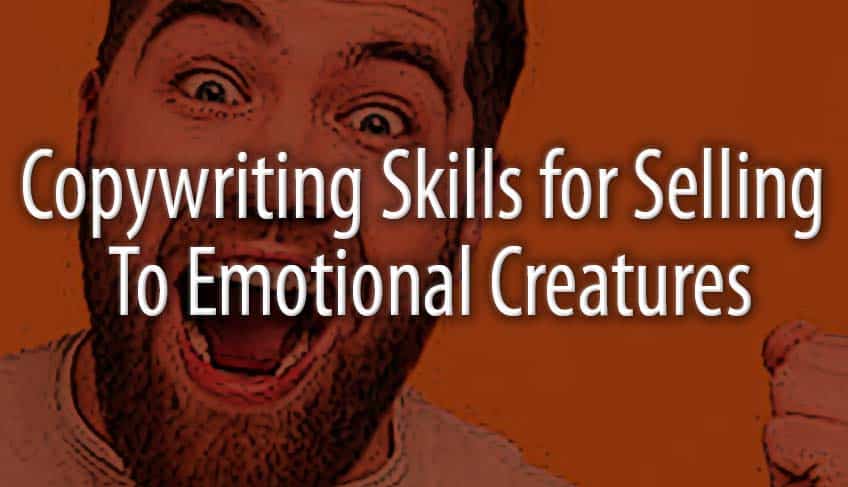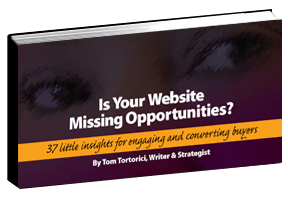
B Y T O M T O R T O R I C I
Your site can have a thousand bullet points of ‘logical’ product benefits. But if you ignore the rich inner feelings of that buyer staring at their laptop, you may still lose the sale.
Faced with four or five providers with similar capabilities, how does the customer choose? Their decision is often based on an emotional reaction that flies below their conscious radar.
Okay, let’s say you’re writing website copy to help the local aquarium complete with other attractions. Maybe you’ve come up with this headline: Bring the family to see all the great marine life exhibits. I guess that works.
But after further developing your copywriting skills, you may find that this works better: Imagine your child’s eyes when they’re eye-to-eye with a dolphin.
What’s the difference between those two options? The first one is selling a bricks-and-mortar venue. The second one is selling an emotional experience.
It’s an experience not just for my kids, but for me, the parent with a credit card, who wants their childhood to be filled with fascinating adventures.
That second headline makes an emotional connection, because it’s personal. It’s focused not just on the aquarium structure, but on my family at the aquarium. Plus it offers a specific benefit (which humans respond to) rather than a vague promise (which they do not).
That emotional connection is often what takes to get web readers to not just look, but actually respond.
Which is no small feat, since we all back out of the vast majority of the sites we visit without typing in any credit card numbers.
Let’s try another one. Let’s say you’re writing copy for a local bank website, with the headline: We have loans available for home improvement. Once again, it says what it needs to say, from the lender’s perspective. But again, after brushing up on your copywriting skills, you might instead go with: Who has money these days for a kitchen renovation? We do.
That second headline is more likely to truly connect, because it starts by echoing what cash-strapped homeowners are already feeling. And it offers an immediate solution.
From the borrower’s perspective, it’s not really “about” the loan. It’s about the new kitchen they’ve been wanting, but putting off, for financial reasons.
So maybe add a sub-head that says something like: With a low-interest loan, you can stop putting it off and start showing it off. Since the bank seems to truly understand what I want to achieve, on a logical and emotional level, I’m much more likely to be drawn in.
Of course I want to invite friends and family to see my stylish new kitchen. Deep down, I know that would make me feel good about myself. It’s a dynamic that’s purely emotional. But by the bank acknowledging it, and pairing it with a break on the interest rate, I now have implicit permission to go ahead with the thing that I really wanted all along.
As a buyer, I’m naturally engaged when it seems like the company’s solutions were conceived and built for me personally.
In other words, the vendor who truly ‘gets me’ is the naturally the one I’ll relate to, trust, and turn to first. And if it’s done right, there are lots of people out there who will feel the same way.
Still, so many businesses out there simply describe what they offer, as if that’s enough to outshine competitors in a crowded marketplace. It’s especially an issue when company insiders write their own web copy; quite naturally, they’re approaching this with a seller mentality rather than a buyer mentality.
Even business-to-business purchases have an emotional component. When an efficient purchase agent negotiates a quality purchase at a low price for their company, don’t you think they feel some emotional satisfaction in that?
If the buyer hasn’t bought yet, there may be some barrier that’s keeping them from moving forward.
As often as not, that barrier is emotional rather than functional.
Now, maybe I’m uncomfortable about boarding my dog for the first time, when I go on vacation. Yes, I know they’ll feed him, but I’m concerned he’ll be scared, lonely or bored all day.
But if the website describes a full schedule of fun doggy activities, accompanied by appropriate images, my apprehension starts to wane. No, the copywriting skills displayed on the kennel’s website don’t matter to my dog. But the mental images they trigger in me make me feel okay about going ahead and scheduling my pup’s stay.
Pay attention to your own sequence of emotions the next time you recognize a need, approach the challenges and options, and finally choose a winning solution.
You’ll learn to be a better seller, because you’ll understand the buyer is an emotionally-driven human just like you. And that insight will translate into more powerful copywriting skills.
Actually, it’s kind of surprising that this simple exercise in self-observation isn’t standard practice for every marketer, and especially for every marketing professional.
But, apparently, no. A quick review of even digital marketing companies’ own websites shows that most are focused on what those insiders feel about their company, vs. what potential clients feel about the issue they’re trying to get solved. They should know better.
Refocusing your message to show empathy for the buyer’s predicament, aspirations, and web of considerations conveys that you’re here to help, not just here to sell.
Use your emotional copywriting skills to show folks you genuinely understand, without simply saying “we understand,” which can come off as, well, patronizing.
Yes, we humans are emotional creatures. That’s why copywriters who only cover the logical reasons to buy, may, without realizing it, be doing only half the job.
Have these perspectives been at all helpful? Then go back and check out the strategic messaging basics in An Atlanta Copywriter Shares 3 Surprising Secrets.
Of course, since I’ve publically shared them, I guess they’re no longer secrets. But you may still find them pretty surprising.
Share It:
 About the Author: Tom Tortorici is an Atlanta copywriter and web content writer who helps companies make a genuine connection with their audience. His classes and conference presentations have focused on how writing, strategy and design can work together to grab attention and interest even among readers with short attention spans. In addition to working directly with businesses, Tom regularly partners with web designers and marketing agencies.
About the Author: Tom Tortorici is an Atlanta copywriter and web content writer who helps companies make a genuine connection with their audience. His classes and conference presentations have focused on how writing, strategy and design can work together to grab attention and interest even among readers with short attention spans. In addition to working directly with businesses, Tom regularly partners with web designers and marketing agencies.
All Posts/Subscribe >
Info for Businesses >
Info for Designers/Agencies >
Tom Tortorici Inc. | Tom@TomTortorici.com | 770-934-7861 | 3101 Rockaway Rd | Atlanta GA 30341

